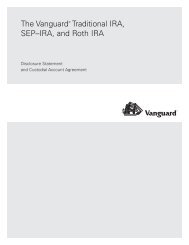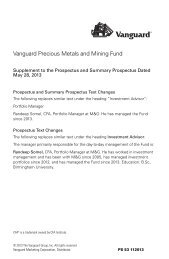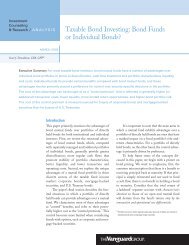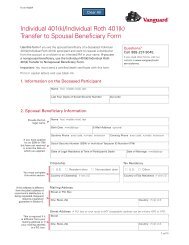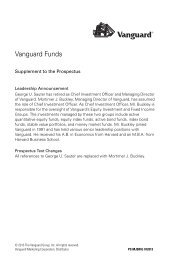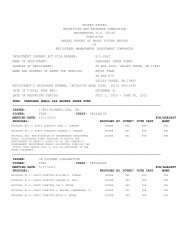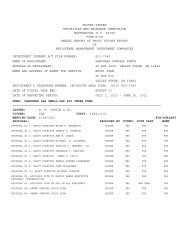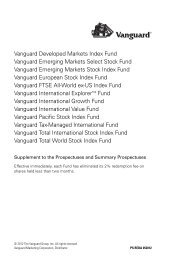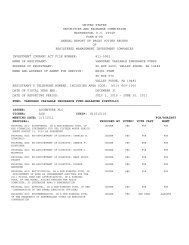Vanguard Variable Insurance Fund Diversified Value Portfolio ...
Vanguard Variable Insurance Fund Diversified Value Portfolio ...
Vanguard Variable Insurance Fund Diversified Value Portfolio ...
You also want an ePaper? Increase the reach of your titles
YUMPU automatically turns print PDFs into web optimized ePapers that Google loves.
Market Exposure<br />
The <strong>Portfolio</strong> invests mainly in common stocks of U.S. companies.<br />
The <strong>Portfolio</strong> is subject to stock market risk, which is the chance that stock<br />
prices overall will decline. Stock markets tend to move in cycles, with periods<br />
of rising prices and periods of falling prices.<br />
To illustrate the volatility of stock prices, the following table shows the best, worst,<br />
and average annual total returns for the U.S. stock market over various periods as<br />
measured by the Standard & Poor’s 500 Index, a widely used barometer of market<br />
activity. (Total returns consist of dividend income plus change in market price.) Note<br />
that the returns shown in the table do not include the costs of buying and selling<br />
stocks or other expenses that a real-world investment portfolio would incur.<br />
U.S. Stock Market Returns (1926–2011)<br />
1 Year 5 Years 10 Years 20 Years<br />
Best 54.2% 28.6% 19.9% 17.8%<br />
Worst – 43.1 –12.4 –1.4 3.1<br />
Average 11.7 9.9 10.5 11.32<br />
The table covers all of the 1-, 5-, 10-, and 20-year periods from 1926 through 2011.<br />
You can see, for example, that while the average annual return on common stocks for<br />
all of the 5-year periods was 9.9%, average annual returns for individual 5-year periods<br />
ranged from –12.4% (from 1928 through 1932) to 28.6% (from 1995 through 1999).<br />
These average annual returns reflect past performance of common stocks; you should<br />
not regard them as an indication of future performance of either the stock market as a<br />
whole or this <strong>Portfolio</strong> in particular.<br />
Mutual funds that invest in stocks can be classified according to market value or<br />
market capitalization. These classifications include small-cap, mid-cap, and large-cap.<br />
It’s important to understand that, for both companies and stock funds, market<br />
capitalization ranges change over time. Also, interpretations of size vary, and there are<br />
no “official” definitions of small-, mid-, and large-cap, even among <strong>Vanguard</strong> fund<br />
advisors. The asset-weighted median market capitalization of the <strong>Portfolio</strong> as of<br />
December 31, 2011, was $54.5 billion.<br />
Stock funds can also be categorized according to whether the stocks they hold are<br />
value or growth stocks or a blend of both. The <strong>Diversified</strong> <strong>Value</strong> <strong>Portfolio</strong> generally fits<br />
into the large-cap value category.<br />
5




